Analysis and Recommendations for Sustainable Tourism Development
VerifiedAdded on 2020/06/05
|17
|4206
|455
Report
AI Summary
This report provides a comprehensive overview of sustainable tourism development, focusing on the Philippine context. It begins by examining the benefits of tourism planning for stakeholders, including competitive advantages, economic development, and resource utilization. The report then explores the advantages and disadvantages of public and private sector tourism planning, highlighting the importance of coordination and addressing potential drawbacks. It delves into the features of tourism development planning at different levels (international, national, and local), emphasizing the significance of interactive planning systems and processes. The report also discusses methods for measuring tourism's impact, covering economic, social, and environmental factors. Furthermore, it addresses sustainability concepts, factors hindering sustainable tourism, and stages in planning for sustainability. The report concludes by examining methods for resolving conflicts of interest, balancing supply and demand, and addressing ethical issues in tourism, particularly in the context of enclave tourism. The report also explores the issues associated with tourism development and offers insights into the future development of the tourism sector.
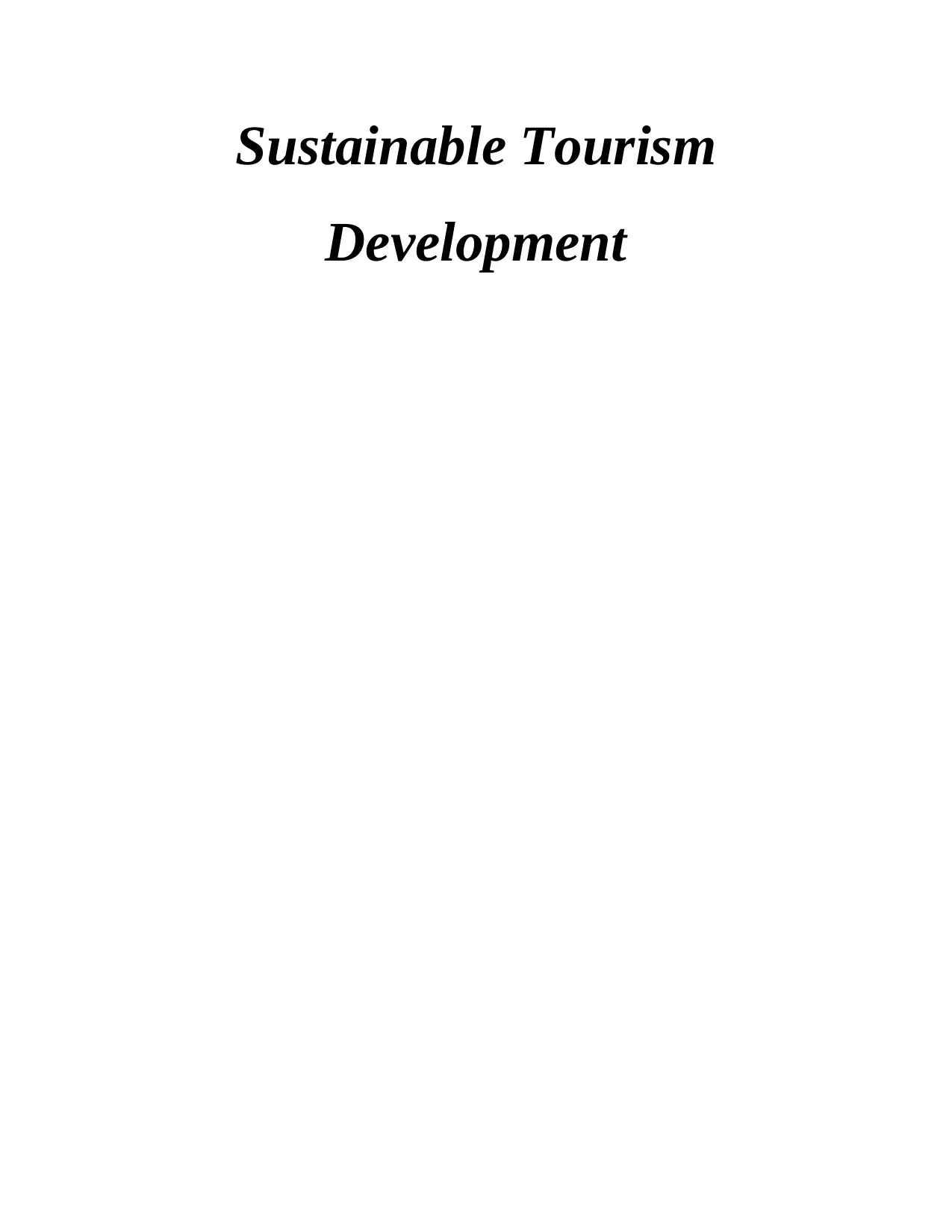
Sustainable Tourism
Development
Development
Paraphrase This Document
Need a fresh take? Get an instant paraphrase of this document with our AI Paraphraser
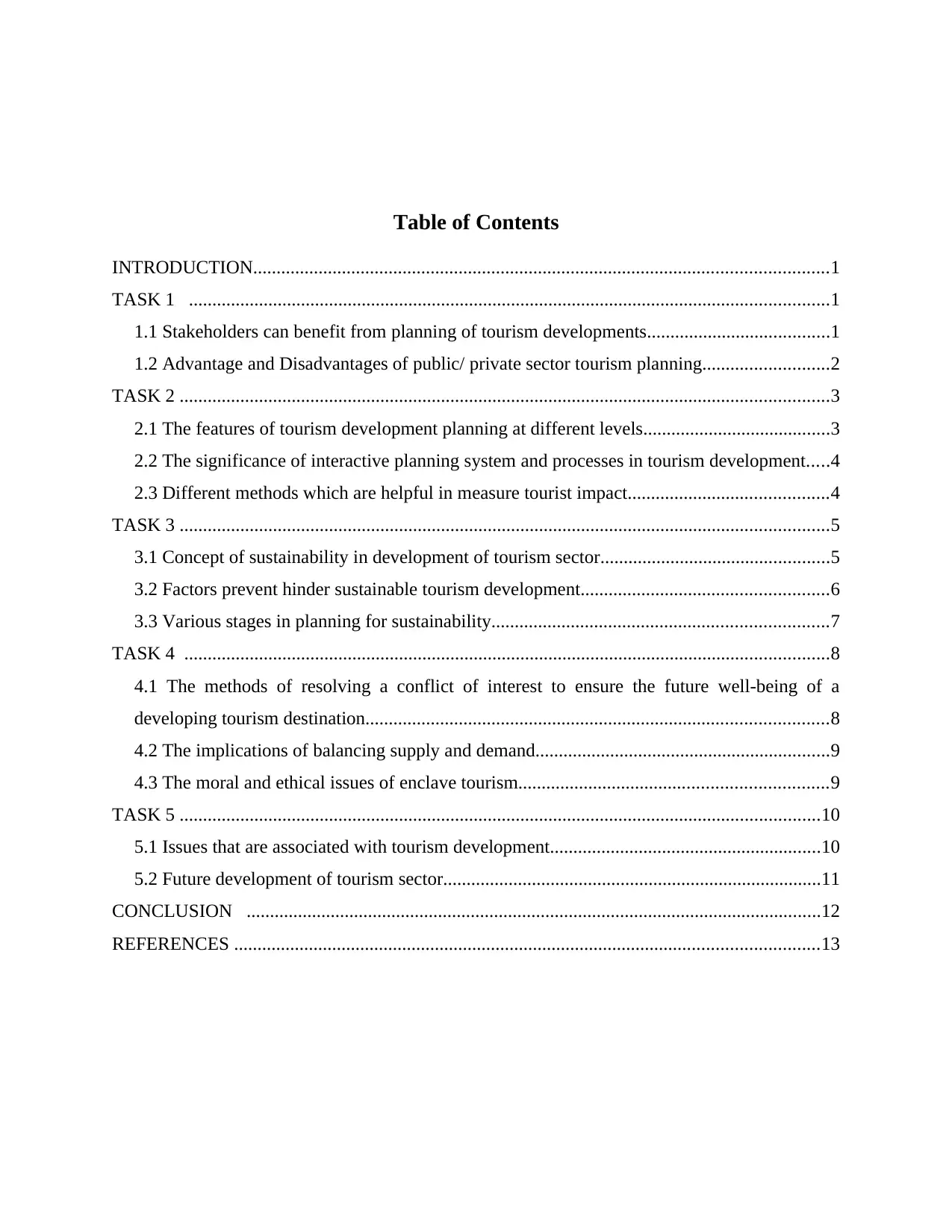
Table of Contents
INTRODUCTION...........................................................................................................................1
TASK 1 .........................................................................................................................................1
1.1 Stakeholders can benefit from planning of tourism developments.......................................1
1.2 Advantage and Disadvantages of public/ private sector tourism planning...........................2
TASK 2 ...........................................................................................................................................3
2.1 The features of tourism development planning at different levels........................................3
2.2 The significance of interactive planning system and processes in tourism development.....4
2.3 Different methods which are helpful in measure tourist impact...........................................4
TASK 3 ...........................................................................................................................................5
3.1 Concept of sustainability in development of tourism sector.................................................5
3.2 Factors prevent hinder sustainable tourism development.....................................................6
3.3 Various stages in planning for sustainability........................................................................7
TASK 4 ..........................................................................................................................................8
4.1 The methods of resolving a conflict of interest to ensure the future well-being of a
developing tourism destination...................................................................................................8
4.2 The implications of balancing supply and demand...............................................................9
4.3 The moral and ethical issues of enclave tourism..................................................................9
TASK 5 .........................................................................................................................................10
5.1 Issues that are associated with tourism development..........................................................10
5.2 Future development of tourism sector.................................................................................11
CONCLUSION ...........................................................................................................................12
REFERENCES .............................................................................................................................13
INTRODUCTION...........................................................................................................................1
TASK 1 .........................................................................................................................................1
1.1 Stakeholders can benefit from planning of tourism developments.......................................1
1.2 Advantage and Disadvantages of public/ private sector tourism planning...........................2
TASK 2 ...........................................................................................................................................3
2.1 The features of tourism development planning at different levels........................................3
2.2 The significance of interactive planning system and processes in tourism development.....4
2.3 Different methods which are helpful in measure tourist impact...........................................4
TASK 3 ...........................................................................................................................................5
3.1 Concept of sustainability in development of tourism sector.................................................5
3.2 Factors prevent hinder sustainable tourism development.....................................................6
3.3 Various stages in planning for sustainability........................................................................7
TASK 4 ..........................................................................................................................................8
4.1 The methods of resolving a conflict of interest to ensure the future well-being of a
developing tourism destination...................................................................................................8
4.2 The implications of balancing supply and demand...............................................................9
4.3 The moral and ethical issues of enclave tourism..................................................................9
TASK 5 .........................................................................................................................................10
5.1 Issues that are associated with tourism development..........................................................10
5.2 Future development of tourism sector.................................................................................11
CONCLUSION ...........................................................................................................................12
REFERENCES .............................................................................................................................13

⊘ This is a preview!⊘
Do you want full access?
Subscribe today to unlock all pages.

Trusted by 1+ million students worldwide
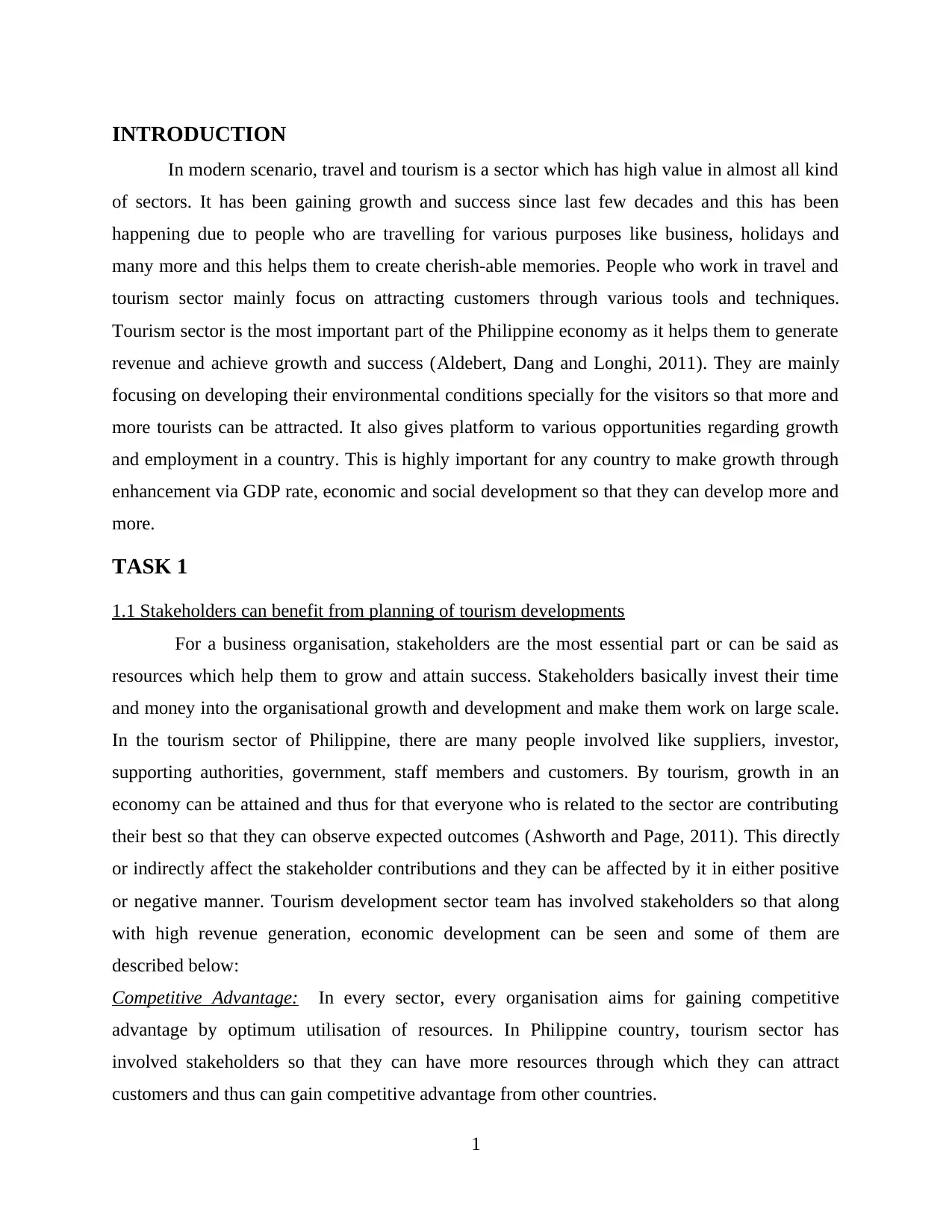
INTRODUCTION
In modern scenario, travel and tourism is a sector which has high value in almost all kind
of sectors. It has been gaining growth and success since last few decades and this has been
happening due to people who are travelling for various purposes like business, holidays and
many more and this helps them to create cherish-able memories. People who work in travel and
tourism sector mainly focus on attracting customers through various tools and techniques.
Tourism sector is the most important part of the Philippine economy as it helps them to generate
revenue and achieve growth and success (Aldebert, Dang and Longhi, 2011). They are mainly
focusing on developing their environmental conditions specially for the visitors so that more and
more tourists can be attracted. It also gives platform to various opportunities regarding growth
and employment in a country. This is highly important for any country to make growth through
enhancement via GDP rate, economic and social development so that they can develop more and
more.
TASK 1
1.1 Stakeholders can benefit from planning of tourism developments
For a business organisation, stakeholders are the most essential part or can be said as
resources which help them to grow and attain success. Stakeholders basically invest their time
and money into the organisational growth and development and make them work on large scale.
In the tourism sector of Philippine, there are many people involved like suppliers, investor,
supporting authorities, government, staff members and customers. By tourism, growth in an
economy can be attained and thus for that everyone who is related to the sector are contributing
their best so that they can observe expected outcomes (Ashworth and Page, 2011). This directly
or indirectly affect the stakeholder contributions and they can be affected by it in either positive
or negative manner. Tourism development sector team has involved stakeholders so that along
with high revenue generation, economic development can be seen and some of them are
described below:
Competitive Advantage: In every sector, every organisation aims for gaining competitive
advantage by optimum utilisation of resources. In Philippine country, tourism sector has
involved stakeholders so that they can have more resources through which they can attract
customers and thus can gain competitive advantage from other countries.
1
In modern scenario, travel and tourism is a sector which has high value in almost all kind
of sectors. It has been gaining growth and success since last few decades and this has been
happening due to people who are travelling for various purposes like business, holidays and
many more and this helps them to create cherish-able memories. People who work in travel and
tourism sector mainly focus on attracting customers through various tools and techniques.
Tourism sector is the most important part of the Philippine economy as it helps them to generate
revenue and achieve growth and success (Aldebert, Dang and Longhi, 2011). They are mainly
focusing on developing their environmental conditions specially for the visitors so that more and
more tourists can be attracted. It also gives platform to various opportunities regarding growth
and employment in a country. This is highly important for any country to make growth through
enhancement via GDP rate, economic and social development so that they can develop more and
more.
TASK 1
1.1 Stakeholders can benefit from planning of tourism developments
For a business organisation, stakeholders are the most essential part or can be said as
resources which help them to grow and attain success. Stakeholders basically invest their time
and money into the organisational growth and development and make them work on large scale.
In the tourism sector of Philippine, there are many people involved like suppliers, investor,
supporting authorities, government, staff members and customers. By tourism, growth in an
economy can be attained and thus for that everyone who is related to the sector are contributing
their best so that they can observe expected outcomes (Ashworth and Page, 2011). This directly
or indirectly affect the stakeholder contributions and they can be affected by it in either positive
or negative manner. Tourism development sector team has involved stakeholders so that along
with high revenue generation, economic development can be seen and some of them are
described below:
Competitive Advantage: In every sector, every organisation aims for gaining competitive
advantage by optimum utilisation of resources. In Philippine country, tourism sector has
involved stakeholders so that they can have more resources through which they can attract
customers and thus can gain competitive advantage from other countries.
1
Paraphrase This Document
Need a fresh take? Get an instant paraphrase of this document with our AI Paraphraser
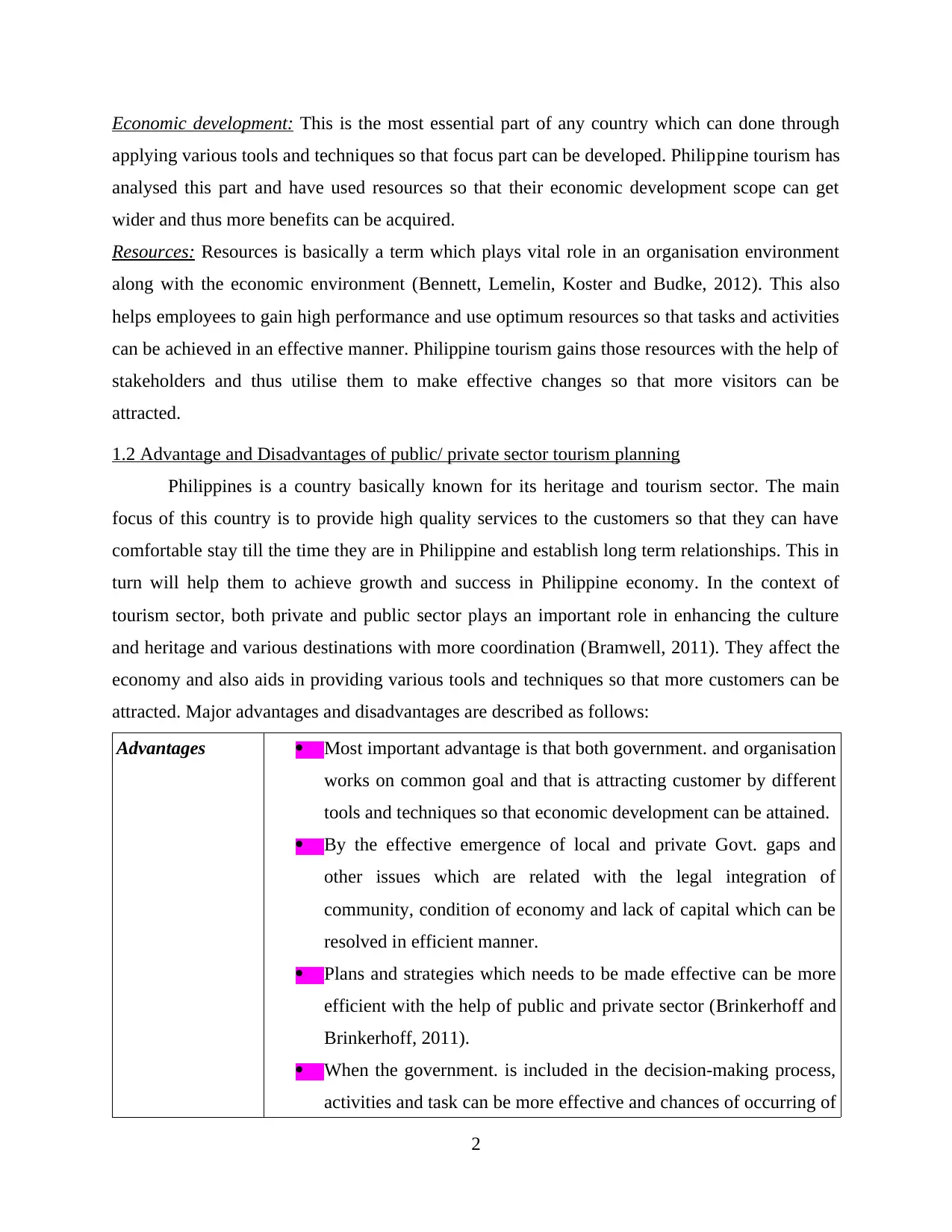
Economic development: This is the most essential part of any country which can done through
applying various tools and techniques so that focus part can be developed. Philippine tourism has
analysed this part and have used resources so that their economic development scope can get
wider and thus more benefits can be acquired.
Resources: Resources is basically a term which plays vital role in an organisation environment
along with the economic environment (Bennett, Lemelin, Koster and Budke, 2012). This also
helps employees to gain high performance and use optimum resources so that tasks and activities
can be achieved in an effective manner. Philippine tourism gains those resources with the help of
stakeholders and thus utilise them to make effective changes so that more visitors can be
attracted.
1.2 Advantage and Disadvantages of public/ private sector tourism planning
Philippines is a country basically known for its heritage and tourism sector. The main
focus of this country is to provide high quality services to the customers so that they can have
comfortable stay till the time they are in Philippine and establish long term relationships. This in
turn will help them to achieve growth and success in Philippine economy. In the context of
tourism sector, both private and public sector plays an important role in enhancing the culture
and heritage and various destinations with more coordination (Bramwell, 2011). They affect the
economy and also aids in providing various tools and techniques so that more customers can be
attracted. Major advantages and disadvantages are described as follows:
Advantages Most important advantage is that both government. and organisation
works on common goal and that is attracting customer by different
tools and techniques so that economic development can be attained.
By the effective emergence of local and private Govt. gaps and
other issues which are related with the legal integration of
community, condition of economy and lack of capital which can be
resolved in efficient manner.
Plans and strategies which needs to be made effective can be more
efficient with the help of public and private sector (Brinkerhoff and
Brinkerhoff, 2011).
When the government. is included in the decision-making process,
activities and task can be more effective and chances of occurring of
2
applying various tools and techniques so that focus part can be developed. Philippine tourism has
analysed this part and have used resources so that their economic development scope can get
wider and thus more benefits can be acquired.
Resources: Resources is basically a term which plays vital role in an organisation environment
along with the economic environment (Bennett, Lemelin, Koster and Budke, 2012). This also
helps employees to gain high performance and use optimum resources so that tasks and activities
can be achieved in an effective manner. Philippine tourism gains those resources with the help of
stakeholders and thus utilise them to make effective changes so that more visitors can be
attracted.
1.2 Advantage and Disadvantages of public/ private sector tourism planning
Philippines is a country basically known for its heritage and tourism sector. The main
focus of this country is to provide high quality services to the customers so that they can have
comfortable stay till the time they are in Philippine and establish long term relationships. This in
turn will help them to achieve growth and success in Philippine economy. In the context of
tourism sector, both private and public sector plays an important role in enhancing the culture
and heritage and various destinations with more coordination (Bramwell, 2011). They affect the
economy and also aids in providing various tools and techniques so that more customers can be
attracted. Major advantages and disadvantages are described as follows:
Advantages Most important advantage is that both government. and organisation
works on common goal and that is attracting customer by different
tools and techniques so that economic development can be attained.
By the effective emergence of local and private Govt. gaps and
other issues which are related with the legal integration of
community, condition of economy and lack of capital which can be
resolved in efficient manner.
Plans and strategies which needs to be made effective can be more
efficient with the help of public and private sector (Brinkerhoff and
Brinkerhoff, 2011).
When the government. is included in the decision-making process,
activities and task can be more effective and chances of occurring of
2
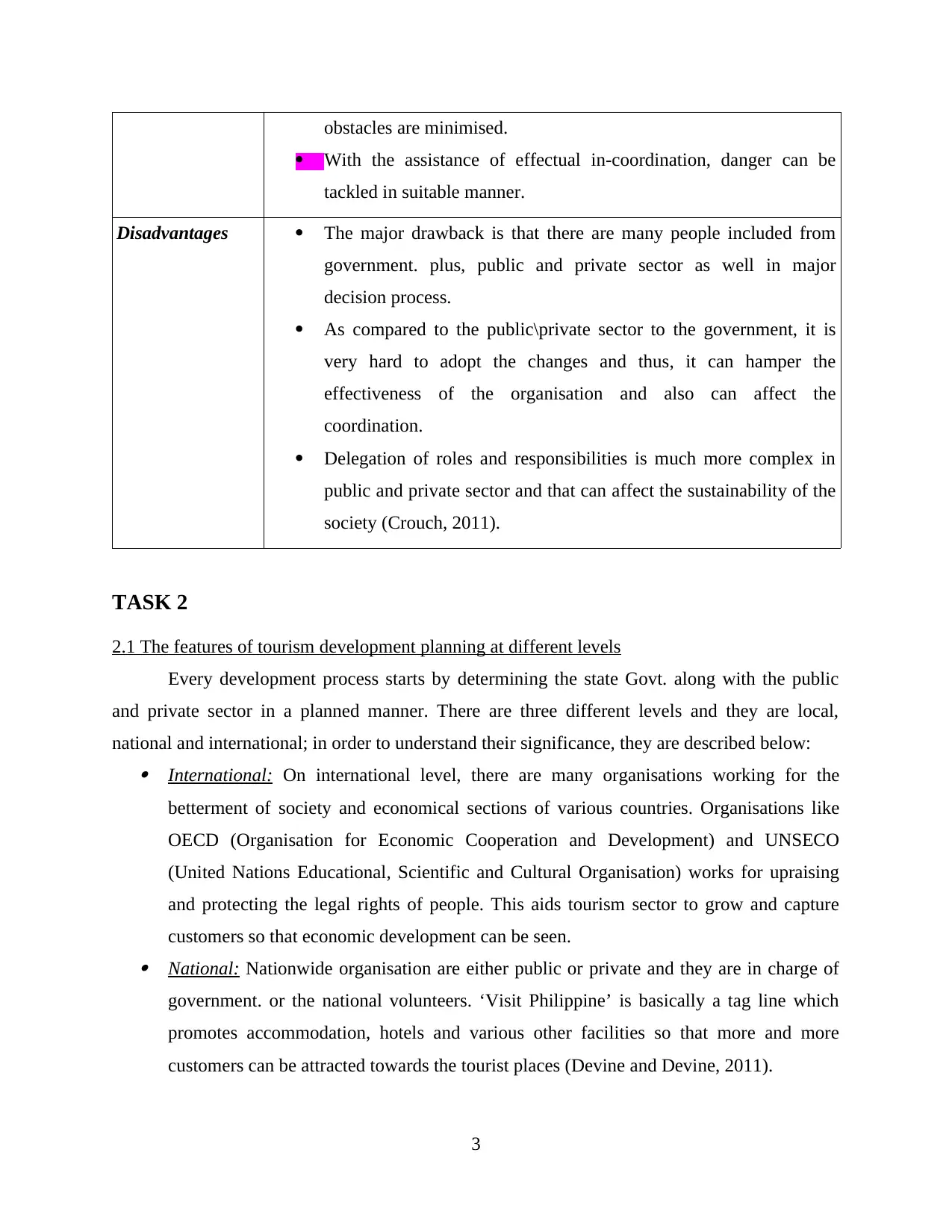
obstacles are minimised.
With the assistance of effectual in-coordination, danger can be
tackled in suitable manner.
Disadvantages The major drawback is that there are many people included from
government. plus, public and private sector as well in major
decision process.
As compared to the public\private sector to the government, it is
very hard to adopt the changes and thus, it can hamper the
effectiveness of the organisation and also can affect the
coordination.
Delegation of roles and responsibilities is much more complex in
public and private sector and that can affect the sustainability of the
society (Crouch, 2011).
TASK 2
2.1 The features of tourism development planning at different levels
Every development process starts by determining the state Govt. along with the public
and private sector in a planned manner. There are three different levels and they are local,
national and international; in order to understand their significance, they are described below: International: On international level, there are many organisations working for the
betterment of society and economical sections of various countries. Organisations like
OECD (Organisation for Economic Cooperation and Development) and UNSECO
(United Nations Educational, Scientific and Cultural Organisation) works for upraising
and protecting the legal rights of people. This aids tourism sector to grow and capture
customers so that economic development can be seen. National: Nationwide organisation are either public or private and they are in charge of
government. or the national volunteers. ‘Visit Philippine’ is basically a tag line which
promotes accommodation, hotels and various other facilities so that more and more
customers can be attracted towards the tourist places (Devine and Devine, 2011).
3
With the assistance of effectual in-coordination, danger can be
tackled in suitable manner.
Disadvantages The major drawback is that there are many people included from
government. plus, public and private sector as well in major
decision process.
As compared to the public\private sector to the government, it is
very hard to adopt the changes and thus, it can hamper the
effectiveness of the organisation and also can affect the
coordination.
Delegation of roles and responsibilities is much more complex in
public and private sector and that can affect the sustainability of the
society (Crouch, 2011).
TASK 2
2.1 The features of tourism development planning at different levels
Every development process starts by determining the state Govt. along with the public
and private sector in a planned manner. There are three different levels and they are local,
national and international; in order to understand their significance, they are described below: International: On international level, there are many organisations working for the
betterment of society and economical sections of various countries. Organisations like
OECD (Organisation for Economic Cooperation and Development) and UNSECO
(United Nations Educational, Scientific and Cultural Organisation) works for upraising
and protecting the legal rights of people. This aids tourism sector to grow and capture
customers so that economic development can be seen. National: Nationwide organisation are either public or private and they are in charge of
government. or the national volunteers. ‘Visit Philippine’ is basically a tag line which
promotes accommodation, hotels and various other facilities so that more and more
customers can be attracted towards the tourist places (Devine and Devine, 2011).
3
⊘ This is a preview!⊘
Do you want full access?
Subscribe today to unlock all pages.

Trusted by 1+ million students worldwide
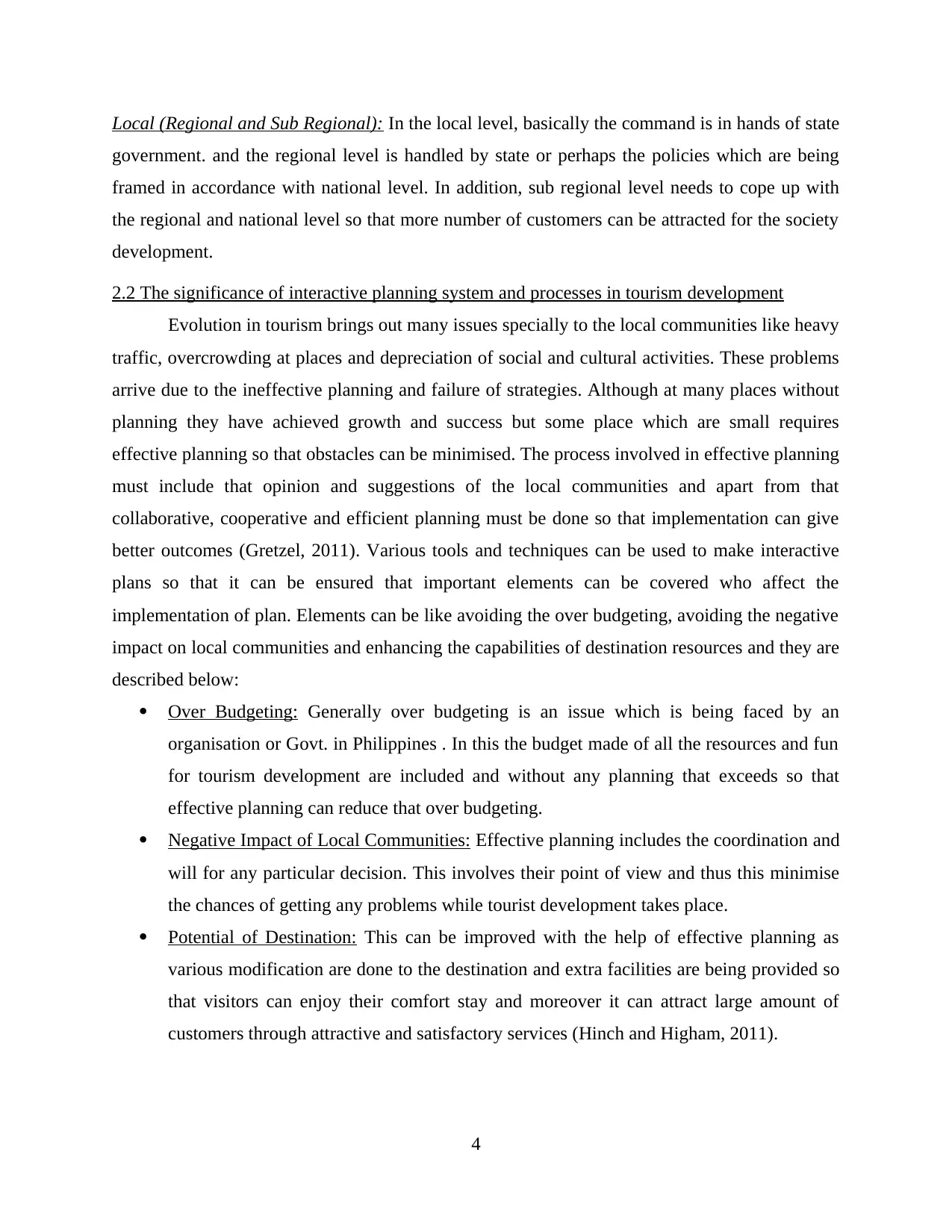
Local (Regional and Sub Regional): In the local level, basically the command is in hands of state
government. and the regional level is handled by state or perhaps the policies which are being
framed in accordance with national level. In addition, sub regional level needs to cope up with
the regional and national level so that more number of customers can be attracted for the society
development.
2.2 The significance of interactive planning system and processes in tourism development
Evolution in tourism brings out many issues specially to the local communities like heavy
traffic, overcrowding at places and depreciation of social and cultural activities. These problems
arrive due to the ineffective planning and failure of strategies. Although at many places without
planning they have achieved growth and success but some place which are small requires
effective planning so that obstacles can be minimised. The process involved in effective planning
must include that opinion and suggestions of the local communities and apart from that
collaborative, cooperative and efficient planning must be done so that implementation can give
better outcomes (Gretzel, 2011). Various tools and techniques can be used to make interactive
plans so that it can be ensured that important elements can be covered who affect the
implementation of plan. Elements can be like avoiding the over budgeting, avoiding the negative
impact on local communities and enhancing the capabilities of destination resources and they are
described below:
Over Budgeting: Generally over budgeting is an issue which is being faced by an
organisation or Govt. in Philippines . In this the budget made of all the resources and fun
for tourism development are included and without any planning that exceeds so that
effective planning can reduce that over budgeting.
Negative Impact of Local Communities: Effective planning includes the coordination and
will for any particular decision. This involves their point of view and thus this minimise
the chances of getting any problems while tourist development takes place.
Potential of Destination: This can be improved with the help of effective planning as
various modification are done to the destination and extra facilities are being provided so
that visitors can enjoy their comfort stay and moreover it can attract large amount of
customers through attractive and satisfactory services (Hinch and Higham, 2011).
4
government. and the regional level is handled by state or perhaps the policies which are being
framed in accordance with national level. In addition, sub regional level needs to cope up with
the regional and national level so that more number of customers can be attracted for the society
development.
2.2 The significance of interactive planning system and processes in tourism development
Evolution in tourism brings out many issues specially to the local communities like heavy
traffic, overcrowding at places and depreciation of social and cultural activities. These problems
arrive due to the ineffective planning and failure of strategies. Although at many places without
planning they have achieved growth and success but some place which are small requires
effective planning so that obstacles can be minimised. The process involved in effective planning
must include that opinion and suggestions of the local communities and apart from that
collaborative, cooperative and efficient planning must be done so that implementation can give
better outcomes (Gretzel, 2011). Various tools and techniques can be used to make interactive
plans so that it can be ensured that important elements can be covered who affect the
implementation of plan. Elements can be like avoiding the over budgeting, avoiding the negative
impact on local communities and enhancing the capabilities of destination resources and they are
described below:
Over Budgeting: Generally over budgeting is an issue which is being faced by an
organisation or Govt. in Philippines . In this the budget made of all the resources and fun
for tourism development are included and without any planning that exceeds so that
effective planning can reduce that over budgeting.
Negative Impact of Local Communities: Effective planning includes the coordination and
will for any particular decision. This involves their point of view and thus this minimise
the chances of getting any problems while tourist development takes place.
Potential of Destination: This can be improved with the help of effective planning as
various modification are done to the destination and extra facilities are being provided so
that visitors can enjoy their comfort stay and moreover it can attract large amount of
customers through attractive and satisfactory services (Hinch and Higham, 2011).
4
Paraphrase This Document
Need a fresh take? Get an instant paraphrase of this document with our AI Paraphraser
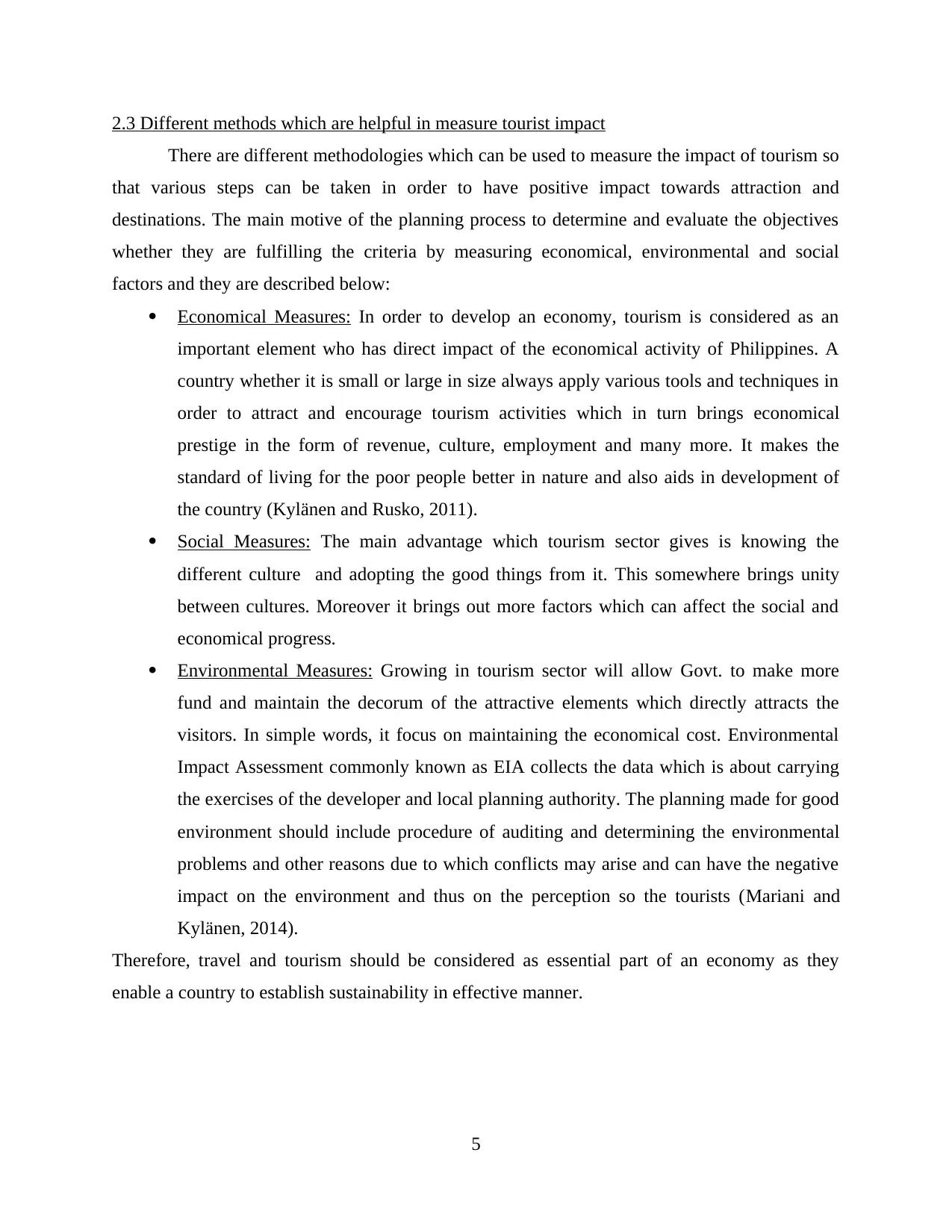
2.3 Different methods which are helpful in measure tourist impact
There are different methodologies which can be used to measure the impact of tourism so
that various steps can be taken in order to have positive impact towards attraction and
destinations. The main motive of the planning process to determine and evaluate the objectives
whether they are fulfilling the criteria by measuring economical, environmental and social
factors and they are described below:
Economical Measures: In order to develop an economy, tourism is considered as an
important element who has direct impact of the economical activity of Philippines. A
country whether it is small or large in size always apply various tools and techniques in
order to attract and encourage tourism activities which in turn brings economical
prestige in the form of revenue, culture, employment and many more. It makes the
standard of living for the poor people better in nature and also aids in development of
the country (Kylänen and Rusko, 2011).
Social Measures: The main advantage which tourism sector gives is knowing the
different culture and adopting the good things from it. This somewhere brings unity
between cultures. Moreover it brings out more factors which can affect the social and
economical progress.
Environmental Measures: Growing in tourism sector will allow Govt. to make more
fund and maintain the decorum of the attractive elements which directly attracts the
visitors. In simple words, it focus on maintaining the economical cost. Environmental
Impact Assessment commonly known as EIA collects the data which is about carrying
the exercises of the developer and local planning authority. The planning made for good
environment should include procedure of auditing and determining the environmental
problems and other reasons due to which conflicts may arise and can have the negative
impact on the environment and thus on the perception so the tourists (Mariani and
Kylänen, 2014).
Therefore, travel and tourism should be considered as essential part of an economy as they
enable a country to establish sustainability in effective manner.
5
There are different methodologies which can be used to measure the impact of tourism so
that various steps can be taken in order to have positive impact towards attraction and
destinations. The main motive of the planning process to determine and evaluate the objectives
whether they are fulfilling the criteria by measuring economical, environmental and social
factors and they are described below:
Economical Measures: In order to develop an economy, tourism is considered as an
important element who has direct impact of the economical activity of Philippines. A
country whether it is small or large in size always apply various tools and techniques in
order to attract and encourage tourism activities which in turn brings economical
prestige in the form of revenue, culture, employment and many more. It makes the
standard of living for the poor people better in nature and also aids in development of
the country (Kylänen and Rusko, 2011).
Social Measures: The main advantage which tourism sector gives is knowing the
different culture and adopting the good things from it. This somewhere brings unity
between cultures. Moreover it brings out more factors which can affect the social and
economical progress.
Environmental Measures: Growing in tourism sector will allow Govt. to make more
fund and maintain the decorum of the attractive elements which directly attracts the
visitors. In simple words, it focus on maintaining the economical cost. Environmental
Impact Assessment commonly known as EIA collects the data which is about carrying
the exercises of the developer and local planning authority. The planning made for good
environment should include procedure of auditing and determining the environmental
problems and other reasons due to which conflicts may arise and can have the negative
impact on the environment and thus on the perception so the tourists (Mariani and
Kylänen, 2014).
Therefore, travel and tourism should be considered as essential part of an economy as they
enable a country to establish sustainability in effective manner.
5
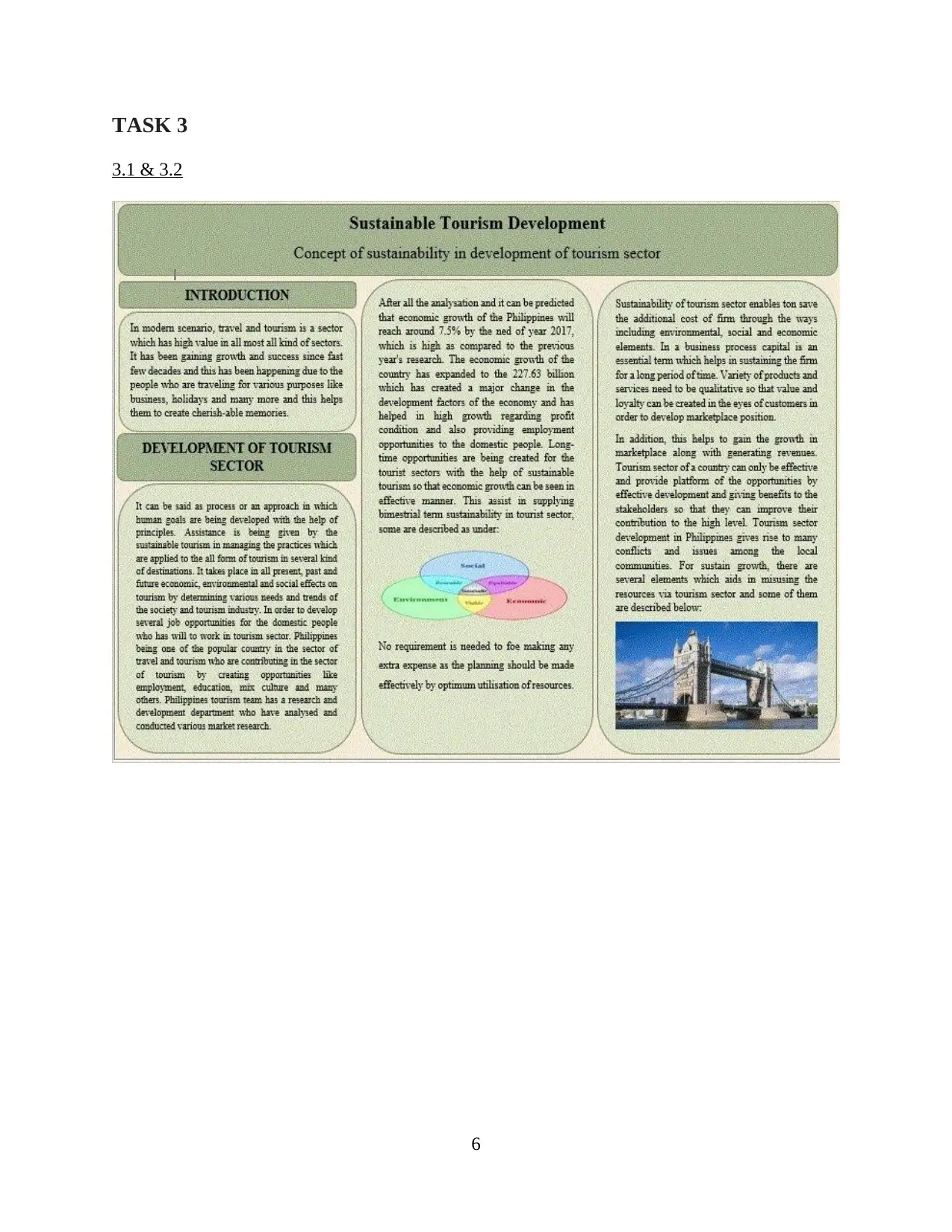
TASK 3
3.1 & 3.2
6
3.1 & 3.2
6
⊘ This is a preview!⊘
Do you want full access?
Subscribe today to unlock all pages.

Trusted by 1+ million students worldwide
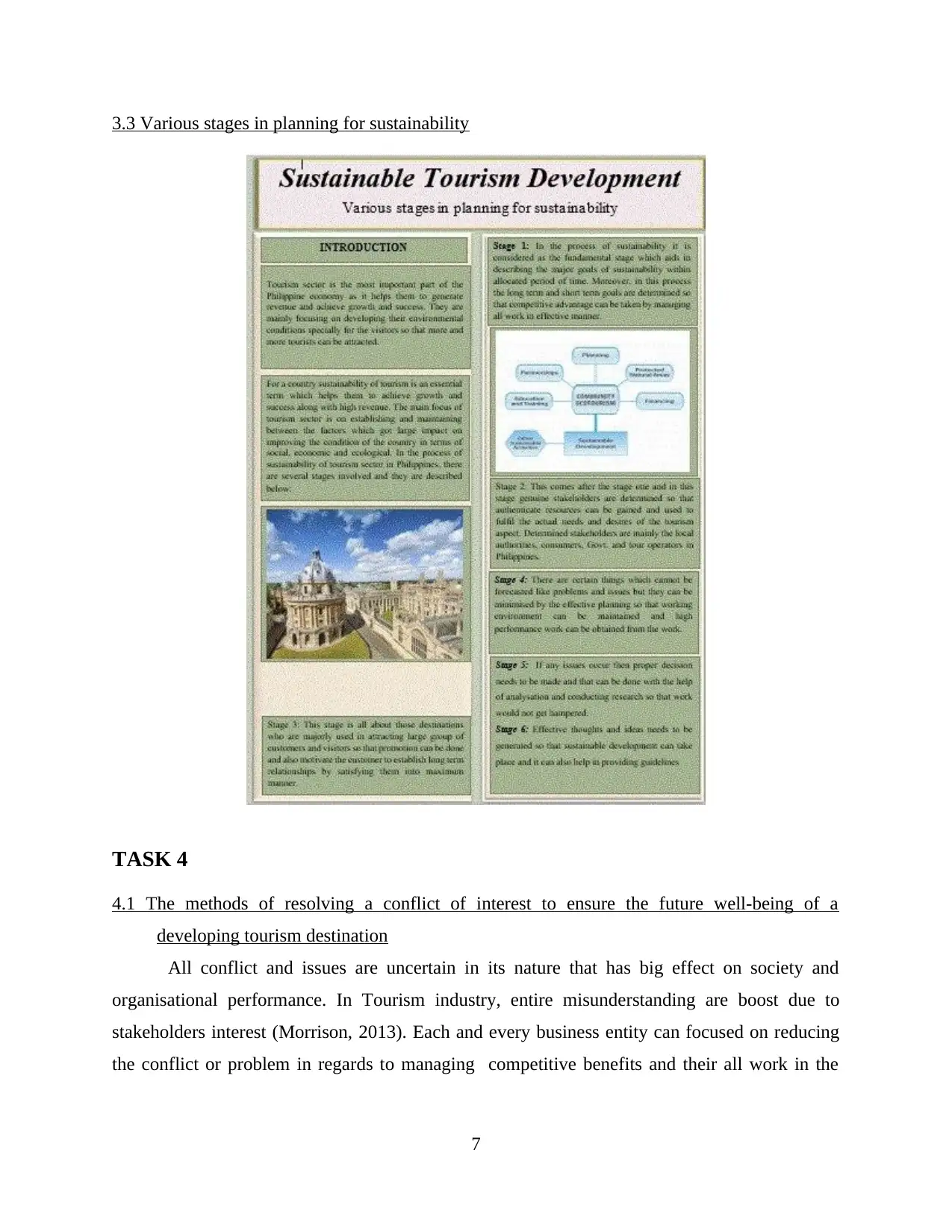
3.3 Various stages in planning for sustainability
TASK 4
4.1 The methods of resolving a conflict of interest to ensure the future well-being of a
developing tourism destination
All conflict and issues are uncertain in its nature that has big effect on society and
organisational performance. In Tourism industry, entire misunderstanding are boost due to
stakeholders interest (Morrison, 2013). Each and every business entity can focused on reducing
the conflict or problem in regards to managing competitive benefits and their all work in the
7
TASK 4
4.1 The methods of resolving a conflict of interest to ensure the future well-being of a
developing tourism destination
All conflict and issues are uncertain in its nature that has big effect on society and
organisational performance. In Tourism industry, entire misunderstanding are boost due to
stakeholders interest (Morrison, 2013). Each and every business entity can focused on reducing
the conflict or problem in regards to managing competitive benefits and their all work in the
7
Paraphrase This Document
Need a fresh take? Get an instant paraphrase of this document with our AI Paraphraser

company. There are certain effective and beneficial approach which supports in resolving issues
are determined under this:
Compromising and Sorting: It is known as fundamental approach of solving all conflict or
misunderstanding which is face by employees at the workplace. Such method is very essential
and necessary for entire parties and workers who are includes in the problem in order to takes
effective involvement in the discussion procedure which is needed for reducing the difficulty in
an effective or efficient manner. Main benefits of this approach is to create better and win
condition for entire parties. Due to this, major complexity which is arises at the time and
accompanist with negotiation. In this, all employees are never fit to forfeit and sacrifice its own
interest (Robinson, Heitmann and Dieke, 2011).
Mediation: It is also very beneficial and valuable approach in order to reduce all issues which
are arise at workplace in an effective way. In this all parties are analysing their possible and best
outcomes. Above situation is very hard and complex for mediator in order to evaluate all
possible outcomes to sort out the issue.
4.2 The implications of balancing supply and demand
In tourism industry, balance between demand and supply is very essential for all
organisation. Both factors are plays as significant role in fulfilling the wants and needs of the
buyers who are more involved to taking advantages of produced better services and products of
company. In Philippine business, international tourism demand that will be reduced over 20%.
Different visitor are attracted with firm for taking better benefits of popular destination and
heritage culture (Saraniemi and Kylänen, 2011). There are certain countries where tourist are
more attracted such as Japan, USA, and Korea etc. Annual revenue of these countries as 42.8,
42.1 and 102.88 (Approx.) Million. This is shows as a growth in different travellers from the
various geographical market which are mainly consist to Asian. Such sector contributors approx
10 % in GDP of countries. Company has to develop and grow potentially in their industry which
covered 7000 natural and beautiful island. It is an very essential for the tourism in order to
determine the basic wants and requirements of buyers to managing supply & demand in
Philippine. Main national tourism strategies is to considered as effective aspects in maintaining
supply and demand of the products in tourism.
8
are determined under this:
Compromising and Sorting: It is known as fundamental approach of solving all conflict or
misunderstanding which is face by employees at the workplace. Such method is very essential
and necessary for entire parties and workers who are includes in the problem in order to takes
effective involvement in the discussion procedure which is needed for reducing the difficulty in
an effective or efficient manner. Main benefits of this approach is to create better and win
condition for entire parties. Due to this, major complexity which is arises at the time and
accompanist with negotiation. In this, all employees are never fit to forfeit and sacrifice its own
interest (Robinson, Heitmann and Dieke, 2011).
Mediation: It is also very beneficial and valuable approach in order to reduce all issues which
are arise at workplace in an effective way. In this all parties are analysing their possible and best
outcomes. Above situation is very hard and complex for mediator in order to evaluate all
possible outcomes to sort out the issue.
4.2 The implications of balancing supply and demand
In tourism industry, balance between demand and supply is very essential for all
organisation. Both factors are plays as significant role in fulfilling the wants and needs of the
buyers who are more involved to taking advantages of produced better services and products of
company. In Philippine business, international tourism demand that will be reduced over 20%.
Different visitor are attracted with firm for taking better benefits of popular destination and
heritage culture (Saraniemi and Kylänen, 2011). There are certain countries where tourist are
more attracted such as Japan, USA, and Korea etc. Annual revenue of these countries as 42.8,
42.1 and 102.88 (Approx.) Million. This is shows as a growth in different travellers from the
various geographical market which are mainly consist to Asian. Such sector contributors approx
10 % in GDP of countries. Company has to develop and grow potentially in their industry which
covered 7000 natural and beautiful island. It is an very essential for the tourism in order to
determine the basic wants and requirements of buyers to managing supply & demand in
Philippine. Main national tourism strategies is to considered as effective aspects in maintaining
supply and demand of the products in tourism.
8
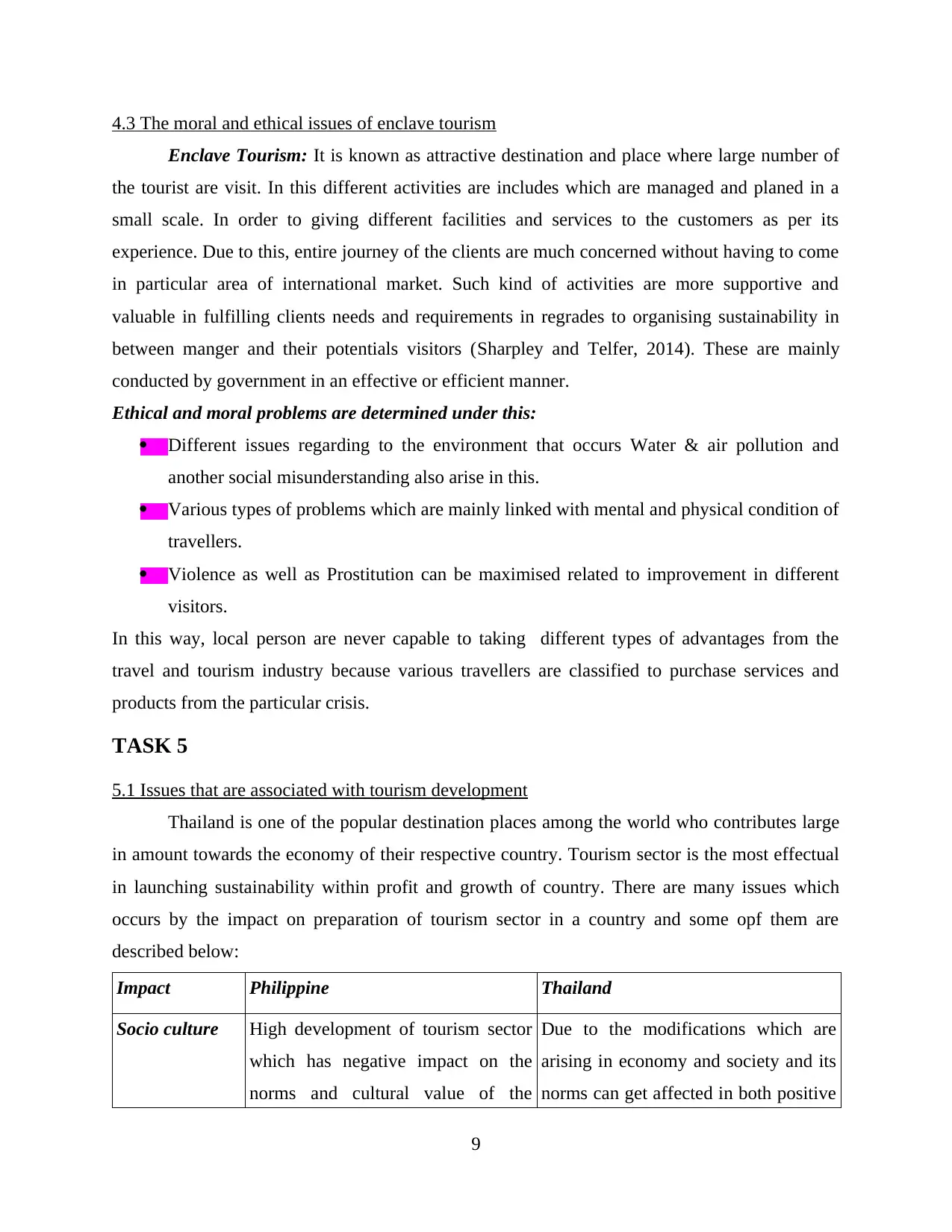
4.3 The moral and ethical issues of enclave tourism
Enclave Tourism: It is known as attractive destination and place where large number of
the tourist are visit. In this different activities are includes which are managed and planed in a
small scale. In order to giving different facilities and services to the customers as per its
experience. Due to this, entire journey of the clients are much concerned without having to come
in particular area of international market. Such kind of activities are more supportive and
valuable in fulfilling clients needs and requirements in regrades to organising sustainability in
between manger and their potentials visitors (Sharpley and Telfer, 2014). These are mainly
conducted by government in an effective or efficient manner.
Ethical and moral problems are determined under this:
Different issues regarding to the environment that occurs Water & air pollution and
another social misunderstanding also arise in this.
Various types of problems which are mainly linked with mental and physical condition of
travellers.
Violence as well as Prostitution can be maximised related to improvement in different
visitors.
In this way, local person are never capable to taking different types of advantages from the
travel and tourism industry because various travellers are classified to purchase services and
products from the particular crisis.
TASK 5
5.1 Issues that are associated with tourism development
Thailand is one of the popular destination places among the world who contributes large
in amount towards the economy of their respective country. Tourism sector is the most effectual
in launching sustainability within profit and growth of country. There are many issues which
occurs by the impact on preparation of tourism sector in a country and some opf them are
described below:
Impact Philippine Thailand
Socio culture High development of tourism sector
which has negative impact on the
norms and cultural value of the
Due to the modifications which are
arising in economy and society and its
norms can get affected in both positive
9
Enclave Tourism: It is known as attractive destination and place where large number of
the tourist are visit. In this different activities are includes which are managed and planed in a
small scale. In order to giving different facilities and services to the customers as per its
experience. Due to this, entire journey of the clients are much concerned without having to come
in particular area of international market. Such kind of activities are more supportive and
valuable in fulfilling clients needs and requirements in regrades to organising sustainability in
between manger and their potentials visitors (Sharpley and Telfer, 2014). These are mainly
conducted by government in an effective or efficient manner.
Ethical and moral problems are determined under this:
Different issues regarding to the environment that occurs Water & air pollution and
another social misunderstanding also arise in this.
Various types of problems which are mainly linked with mental and physical condition of
travellers.
Violence as well as Prostitution can be maximised related to improvement in different
visitors.
In this way, local person are never capable to taking different types of advantages from the
travel and tourism industry because various travellers are classified to purchase services and
products from the particular crisis.
TASK 5
5.1 Issues that are associated with tourism development
Thailand is one of the popular destination places among the world who contributes large
in amount towards the economy of their respective country. Tourism sector is the most effectual
in launching sustainability within profit and growth of country. There are many issues which
occurs by the impact on preparation of tourism sector in a country and some opf them are
described below:
Impact Philippine Thailand
Socio culture High development of tourism sector
which has negative impact on the
norms and cultural value of the
Due to the modifications which are
arising in economy and society and its
norms can get affected in both positive
9
⊘ This is a preview!⊘
Do you want full access?
Subscribe today to unlock all pages.

Trusted by 1+ million students worldwide
1 out of 17
Related Documents
Your All-in-One AI-Powered Toolkit for Academic Success.
+13062052269
info@desklib.com
Available 24*7 on WhatsApp / Email
![[object Object]](/_next/static/media/star-bottom.7253800d.svg)
Unlock your academic potential
Copyright © 2020–2025 A2Z Services. All Rights Reserved. Developed and managed by ZUCOL.





